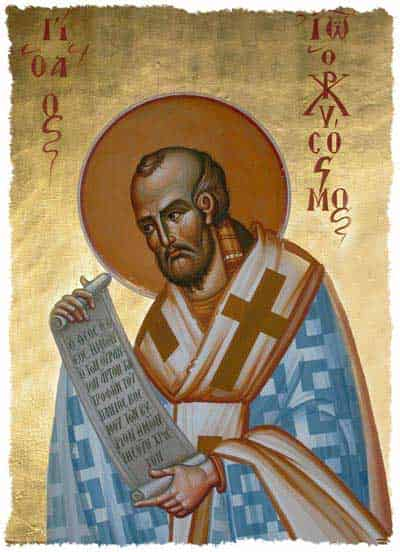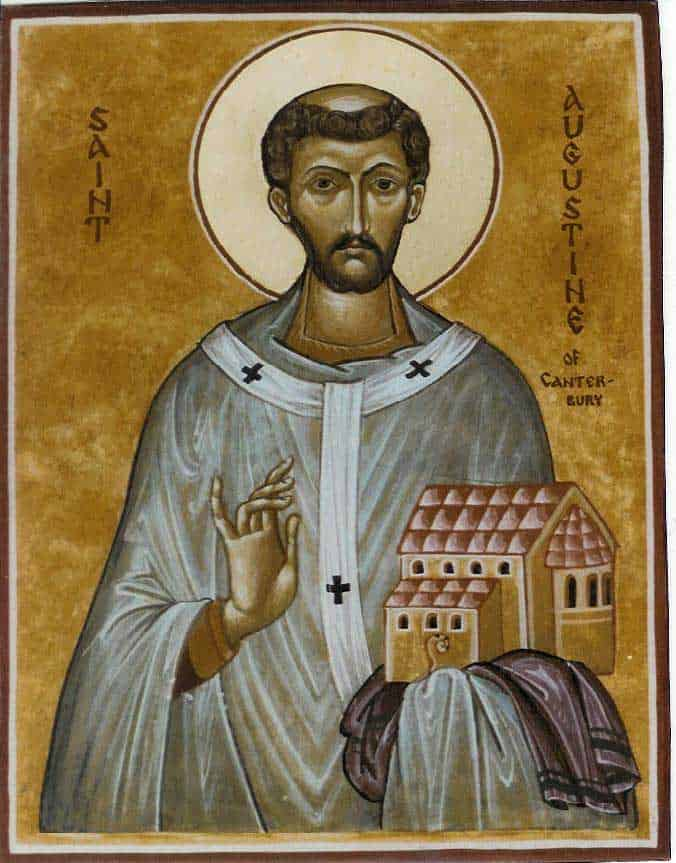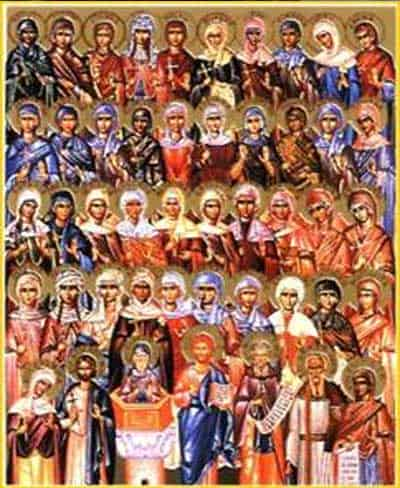Saint John Chrysostom Catholic Saint
CATHOLIC SAINTS 28-12-2023, 19:38

Saint John Chrysostom
Catholic Saint
st.John Chrysostom-Doctor of the Church,
Greek Father of the Church,
bishop of Constantinople,
esteemed theologian
Feast Day : September 13 (in the West); November 13 (in the East)
Patronage: orators; preachers
Also known as: “the golden-mouthed” for his eloquence as a speaker
John Chrysostom is considered to be the greatest of the Greek fathers of the church and one of the greatest of all preachers of the faith. More writings of his are extant than of any other Doctor of the Church. His exact surname is not known. Chrysostom, which comes from the Greek chrysostomos (“golden-mouthed”) was first used in 553 in the Constitution of Pope Vigilius (r. 537–555). The chronology of John’s life is incomplete. He lived during a time of great political and religious unrest and intrigue. John was born ca. 347 in Antioch. His father, Secundus, was a high-ranking officer in the Syrian army. Secundus died shortly after John’s birth, leaving his young wife, Anthusa, to raise John and his older sister. Anthusa sent John to the best schools in Antioch, where he attained considerable Greek scholarship and classical learning.
Around 367 John met Bishop Meletius, patriarch of Antioch and a key figure in a schism between bishops. Under Meletius’s influence, John was drawn into an ascetic and religious life. After three years, he was baptized and ordained lector. He entered one of the ascetic societies near Antioch—under the spiritual direction of Carterius and devoted himself to prayer, study of the Scriptures and manual labor. He began to write on ascetic and monastic subjects. After four years, John went off to live in a cave near Antioch. He spent two years there, but his fasts and exposure to harsh elements nearly ruined his health. He returned to Antioch and his post as lector. Around 381 Meletius made John deacon and left for Constantinople. The new bishop, Flavian, ordained John a priest in 386. During this period and until 397, John enjoyed the golden age of his life. He was a prolific writer and a popular, charismatic preacher. His fame spread throughout the Byzantine Empire. In 397 or 398 he was abruptly sent to Constantinople to replace Bishop Nectarius, who had died. John found himself thrust into a difficult role. Constant intrigue and a lavish lifestyle prevailed at court, and intrigue and a lax lifestyle abounded in secular quarters as well. John was scandalized by the dress of women. He set about asserting discipline and reform. Initially, Empress Eudoxia was a supporter. John achieved great popularity with the people but was not able to establish order for long. Disputes and intrigues earned Eudoxia’s alienation. She took many of his sermons—such as the one against the vanity of women as personal affronts.
Rivals and malcontents, under the leadership of Theophilus, patriarch of Alexandria, also made trouble for John. When Theophilus was ordered in 402 to apologize for his actions to a synod presided over by John, he managed to twist his situation around. In 403 he assembled a synod of 36 bishops and archbishops, called the Oak, and made charges against John, including one that he had called Eudoxia a “Jezebel.” John was ordered to appear before the synod, comprised chiefly of his enemies, and apologize. John refused and was exiled by Emperor Arcadius. This agitated the people, and after three days of public uproar Eudoxia recalled him to Constantinople. Theophilus and his supporters were obliged to flee the city. The victory for John did not last long. In 404 a silver statue of Eudoxia went up before the great church of the Holy Wisdom. The public celebrations were loud and scandalous, and John spoke out against them. Eudoxia, affronted, recalled Theophilus and had John exiled for a second time. Soon after John left the city, a huge fire broke out and destroyed the cathedral, senate house and other buildings. John’s followers were accused and prosecuted. John was sent to Caucasus, a rugged area on the eastern frontier of Armenia continually under invasion by Isaurians. It took him 70 days to walk there. In 405 John was forced to flee in order to escape the barbarians. Meanwhile, he continued to write to his supporters and to maintain hope for his restoration to Constantinople. John appealed to Rome for help. Emperor Honorius and Pope Innocent I (r. 401–417) attempted to intercede on his behalf, but their legates were jailed and then sent home. The pope broke off contact with the patriarchs of Alexandria and Antioch. In the summer of 407 John was marched toward Pithyus, located near the Caucasus Mountains at the extreme edge of the empire. As his enemies hoped, he did not survive the journey. His health already was impaired by previous illnesses, and the soldiers who accompanied him made the conditions as cruel as possible.
He was made to walk for long periods regardless of scorching heat, freezing cold and downpours of rain. On September 14, he asked to rest at Comana in Cappadocia but was forced to continue his march. When he was too weak to continue, the party returned to the chapel of St. Basiliscus near Comana, where John died within hours. His final words were “Doxa to theo panton eneken” (“Glory be to God for all things”). John was buried at Comana, and his remains were translated to Constantinople on January 27, 438, with great pomp and fanfare. He was entombed in the Church of the Apostles, where Eudoxia, who had died in 404, also was buried. John Chrysostom’s most famous work is his book On the Priesthood, written as a dialogue between himself and St. Basil. His 21 sermons (he may not have written the 19th) from his Antioch days are full of moral, dogmatic and historical knowledge. He wrote hundreds of homilies on the Scriptures.
Some 238 of his letters survive; most are from his days in exile. He was quoted as an authority as early as 415 by Pelagius and 421 by St. Jerome, one of the great Doctors of the Church himself. John also was invoked at the Council of Ephesus in 431. During the Reformation, debate arose as to whether John had been a Catholic or a Protestant, in part because he did not clearly advocate confession and the primacy of the pope. However, his writings do assert the authoritative teaching of the Church as the one Bride of Christ. John is called the Doctor of the Eucharist for his witness to the Real Presence. In art he is portrayed as a cardinal attended by a lion, or as a hermit.

st.Augustine of Canterbury Patronage: England Also known as: Austin Augustine was by all accounts a timid...
Learn more
Do the Devil and Demons Really Exist? The story of job tells how Satan asked God for a chance to test Job...
Learn more
Bible Quotes Proverbs 3:6 Mobile Wallpaper Christian mobile wallpapers Proverbs 3:6 In all your ways...
Learn more


